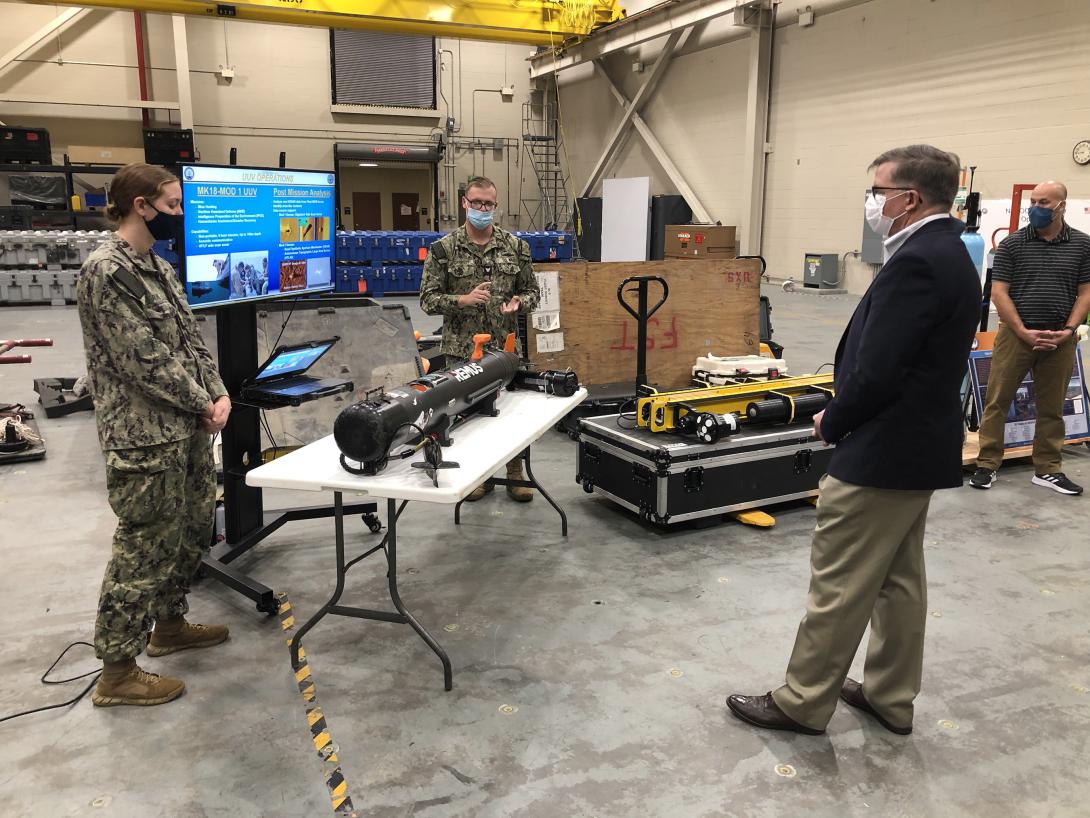NGA Maps Out Digital Priorities for GEOINT
The National Geospatial-Intelligence Agency’s (NGA’s) Source Operations and Management Directorate is moving to a more digitally based world of mapping and information to support the key military missions and other governmental efforts. The Source Directorate’s operational priorities of leveraging—commercial geospatial intelligence, or GEOINT; assured positioning, navigation, timing and targeting; integrated collections; and modernized GEOINT dissemination—are grounded in the agency’s effort to construct a larger digital environment, explains James Griffith, director, Source and Operations Management Directorate, NGA.
Griffith oversees the NGA’s collection and creation of GEOINT for Department of Defense customers, the intelligence community, other organizations, allies and partners, all who have a broad range of national security missions. The Source Directorate is responsible for delivering GEOINT products and services to these customers, and as Griffith brokers for such content, more and more GEOINT is coming from the private sector.
Last fall, the NGA announced that it would allow its analysts for the first time to use commercial solutions as primary sources. The agency has enabled the purchase of commercial geospatial intelligence-related solutions for some time as part of its procurement approach. The problem, though, had been a bottleneck in the cultural adoption of those capabilities amongst the NGA analysts and the agency’s greater workforce. Previously, analysts had used private sector sources of geospatial data and information as an augmenting or secondary, confirming source. By making commercial geospatial intelligence a prime source, the policy message signals a significant paradigm shift that it is ready to depend on industry to help supply more sources, tools and innovation as a first source.
So far, one year in, the move to make those types of sources available as the foundation or the beginning of the intelligence gathering process has been successful, Griffith noted.
“In the past, from a tradecraft perspective, we really focused on ‘I want to answer this question,’ or ‘I need this data set so I’m going to go and I’m going to task this system to give me that answer,’” he explains. “In the future, it’s going to be,‘We need this answer or that data set, and here are all of the options we have for doing it in the various speeds of delivery.’ And then [choosing] the best one, because speed is not always the most important criteria. Sometimes it may be accuracy; sometimes it may be quantity.”
Indeed, the range of commercial options has increased rapidly, even in the last few years, the director continues. “When you think about the evolution of commercial GEOINT and the availability of additional, not just commercial overhead but commercial services, that has been growing over the last decades, and certainly at a very rapid pace over the last five years,” he states. “You start thinking in terms of what is it that we need to ‘task’ and what is it that is available through a commercial vendor as a service or as data sets that we can buy that will meet a mission need today, without having to task one of the several overhead systems that’s available.”
Having such a greater pool of commercial options shifts the NGA employees’ methods in how they craft geospatial intelligence—and requires an added training component, Griffith notes. “There’s going to be different aspects and attributes we will be looking for in the data to answer questions or provide us the data we need to build products,” he says. “Our folks need to be much more aware of all of the available sources of data to answer the questions. And we need to train our folks to be able to deal with that emerging environment today so that as more and more and more of these services, and more and more of this data becomes available, we’re not playing catch-up.”
Already, the GEOINT workplace requires specific skill sets, not all of which can be taught in traditional collegiate environments. This remains one of the directorate’s challenges—in addition to showing the dearth of commercial sources, Griffith confirms. “A lot of our missions require very specific technical skills and in some cases those skills are not from a degree program or certification,” he says. “There really is no one university, college or certification source that provides a person who’s ready to go and do the [GEOINT] mission, especially as the mission is changing. We’re having to adjust what our tradecraft is as the mission continues to evolve. My number one challenge is that we want to make sure that we are thoughtfully bringing in folks with the appropriate technical backgrounds and then ensuring that we are then providing the additional education or training that’s required for them to do functions within our mission set.”
To procure commercial GEOINT, the Source Directorate harnesses a range of contract vehicles. “For several years now, we have been using various contract mechanisms to get after various problems,” the director shares. “We use a variety of bailment agreements, no cost contracts, CRADAs [Cooperative Research and Development Agreements], the InQTel work program and other contracting authorities to get access to or providing our vendors access to data as required in the easiest, fastest ways possible.
“In some cases, a vendor will come to us—and we encourage this—and say, ‘We have this capability that we would like you to evaluate as we think it can fit these mission needs,’” Griffith continues. “Recently, we put out our research challenges for our needed technology areas, which you can find on the NGA public website.”
To the extent that we can do it, and in the pace that we can do it at, we are looking to centralize all access to our foundation products. It will take us a couple years to get there. Today, frequently, for some of these communities, if you know where to go get it, you can find it. If you don’t, you can’t, and we need to fix that. It has been a goal of NGA for a while. We are taking steps and within the next couple of years we will be in a place where it will be much easier to find and access our data. Our long-term sustainment of that is really to get us to that kind of machine-to-machine digital space.
Another focus for the directorate is obtaining assured positioning, navigation, timing and targeting (PNT&T) GEOINT. And admittedly, it is an area of rebuilding for the directorate, both in terms of sources and capabilities as well as with its workforce.
“Our main focus for the last year or so is on assured PNT&T and really strengthening our bench strength in terms of our technical capabilities in the geodetic sciences,” the director states. “We’re doing that through internal programs, but we’ve also established relationships with multiple universities in Saint Louis and across the country, and we are building programs with them. NGA is not the only one using these programs. Our partners have started using them. We are trying to be thoughtful and strategic in how we are hiring people and then what kind of training we’re providing internally and externally to ensure that we’re getting the right skill sets we need. This takes a little more time, but it’s critical in the technical fields that we are so reliant upon in our business. It is one of those areas where we as community kind of assumed it would always be there and maybe it didn’t always get the attention it required, and so there is some catch-up that we are doing.”
In addition, the Source Directorate is responsible for providing safe navigation data for the maritime and aeronautical domains. “NGA is central when it comes to the production of data and products to support maritime and aeronautical safety of navigation,” Griffith says. “On a regular basis we provide data to all of the Department of Defense’s ships, for whatever number of ships the Navy has for any operations they’re doing outside the continental United States, worldwide, for its maritime navigation support. [This could be] for 160-plus Navy vessels and 70,000-plus U.S. sailors and Marines on a daily basis. The aeronautical offices provide products for over 13,000 DoD aircraft flying thousands of flights a day doing very unique missions. We make the same data available to other U.S. government organizations that need it in partnership from a safety of navigation perspective.”
The organization is also working with several allies, under long-running partnerships, to provide maritime and aeronautical safety navigation data. “We do work with them to ensure that we’re exchanging data and not duplicating our production,” he adds.
Making sure those products are digitized will continue to be a priority for the Source Directorate as it modernizes its workflows. “As an example, things that we were doing two years ago completely by hand are now automated,” Griffith shares. “We’re able to pass data directly to some of our mission partners so they can do their own production using our data and that was not possible without the work that’s being done within our GEOINT Information Office.”
Moreover, GEOINT processes that once involved large paper maps have evolved into speedy digital deliveries, aiding warfighters across the globe. “We produce Department of Defense mil-spec maps and charts for the community,” Griffith explains. “Way, way back, we used to actually print those maps and charts and then distribute them out, and then that responsibility transferred to DLA [Defense Logistics Agency]. For DLA we used to send them basically hardcopy media with our updates every month and now we don’t do that. It’s all digital, so DLA can then produce the maps and charts as requested by various users. Additionally, that same data, because it’s now all digitally available, we can make available to an officer at a combatant command to have a map or chart printed for them without needing to go all the way back to DLA. That digitization has allowed us to really take what used to be a very person-in-the-loop kind of product development directly into the hands of a soldier, sailor, airman, Marine or guardian and the services have adapted several capabilities to give their users handheld devices.
Lastly, as part of its digital modernization, Source is working to make centralized platforms for its GEOINT. “To the extent that we can do it, and in the pace that we can do it at, we are looking to centralize all access to our foundation products,” he notes. “That’s a work in progress. It will take us a couple years to get there. Today, frequently, for some of these communities, if you know where to go get it, you can find it. If you don’t, you can’t, and we need to fix that. It has been a goal of NGA for a while. We are taking steps and within the next couple of years we will be in a place where it will be much easier to find and access our data. Our long-term sustainment of that is really to get us to that kind of machine-to-machine digital space.”



Comments